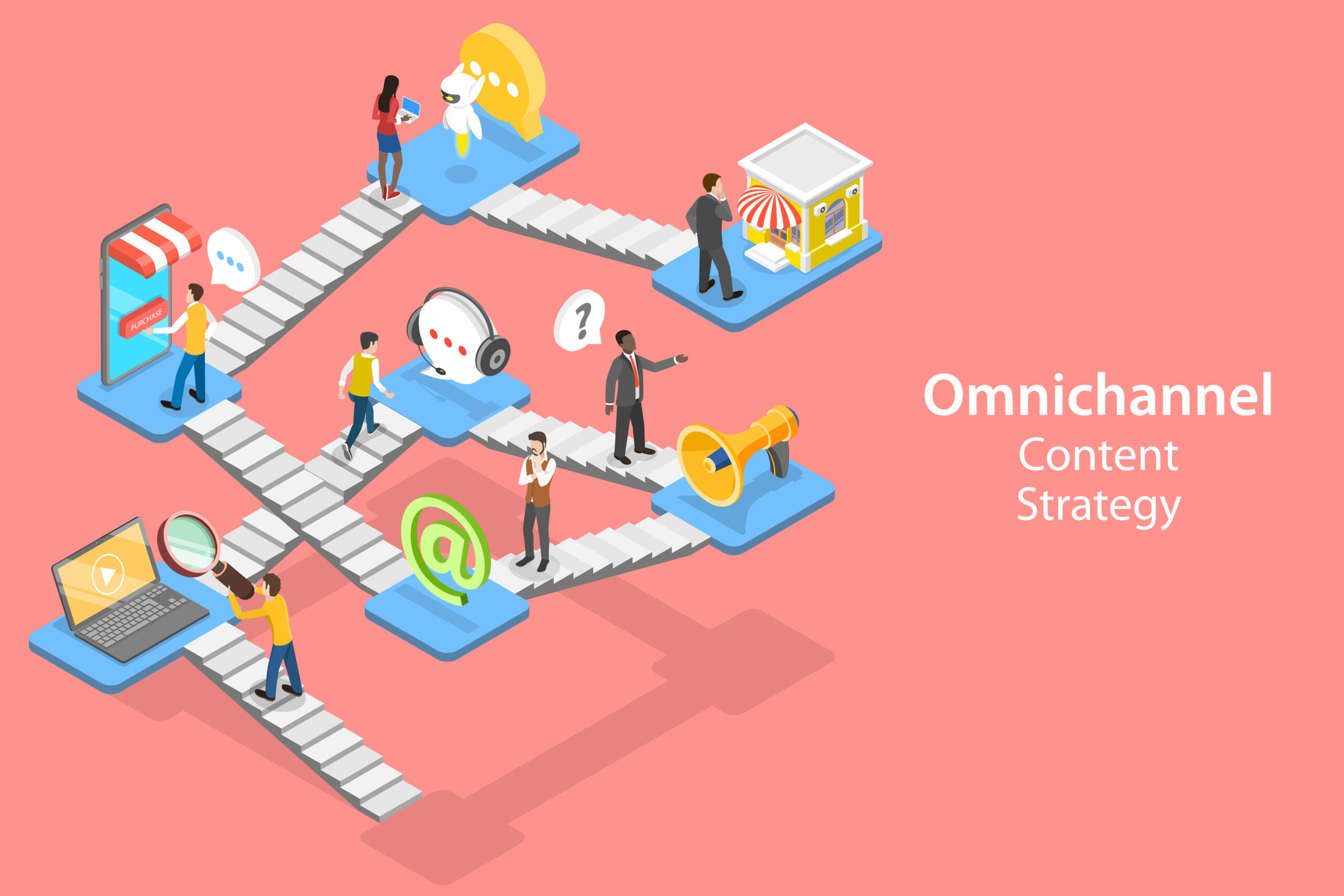Small to medium-sized businesses often gravitate towards traditional marketing methods like direct mailers and local magazines for their ease and affordability. However, merely increasing a business’s visibility without leading to meaningful customer action, equates to awareness which, if you have read my articles previously, you know I believe to be a useless marketing tactic. This kind of set-it-and-forget-it marketing, which I refer to as linear marketing, lacks the depth and engagement potential of more integrated approaches.
Linear marketing is characterized by its hands-off approach after the initial setup: once the content is approved, a vendor takes charge of everything else, enabling the business owner to carry on with regular tasks without distraction. This strategy is considered “linear” because it progresses in one direction without incorporating any omnichannel elements—such as QR codes or targeted web pages—that could significantly enhance customer engagement and provide valuable insights. In essence, linear marketing doesn’t fully capitalize on the opportunities to connect more deeply with potential customers, a key advantage of an omnichannel strategy.
Despite some SMB owners believing that adopting an omnichannel strategy is beyond their resources, evidence from case studies, such as those by Valpak, suggests otherwise. Incorporating omnichannel strategies, particularly those with direct response mechanisms, can greatly improve conversion rates and overall business results. Moreover, it’s often more accessible and requires less time and expertise than many anticipate, minimizing distraction from daily operations. This article aims to demystify omnichannel marketing and demonstrate that enhancing marketing effectiveness through integrated strategies is both achievable and beneficial, without significantly diverting focus from core business activities.

Quick Sidebar: Omnichannel vs. Multichannel
Before we continue, I want to ensure we are all clear on the distinction between omnichannel and multichannel. While multichannel isn’t related to the subject matter of this article, I feel it is important to explain why, as these two terms are often applied interchangeably whereas they are quite different. In my view, the most pertinent difference between the two is that multichannel should not be uttered from our lips these days. It once had its purpose but I struggle to find any, today.
Multichannel marketing employs a range of channels — email, social media, direct mail, and websites — to engage with the audience. Its defining feature is the independence of each channel; there’s no crossover or synergy between them, making each effort a standalone attempt to connect with customers.
Omnichannel marketing also uses these diverse channels but integrates them to create a cohesive customer experience. Here, each channel recognizes and builds upon the interactions a customer has with the others. This approach ensures that whether a customer sees a sale in an email, clicks on a related social media ad, or uses a direct mail coupon, their journey feels continuous and connected, enhancing their overall experience with your brand.
Examples:
Multichannel: The local cafe rolls out its new seasonal menu and decides to leverage both email and Instagram, but treats each channel separately. They start by sending out an email newsletter, showcasing the new menu items and highlighting the cafe’s cozy ambiance, without any mention of engaging on social media or a specific call to action that bridges to another platform. On Instagram, they independently post vibrant photos of the seasonal dishes and encourage followers to visit the cafe, but there’s no reference to the email newsletter or an integrated promotion that connects the two channels. Each channel operates in isolation, aiming to attract customers through its unique content and offers, yet missing the opportunity for cross-promotion or to create a more engaging, interconnected customer journey.
Omnichannel: The local cafe, aiming to spotlight their new seasonal menu, crafts an omnichannel campaign around email and social media synergy. They dispatch an email newsletter introducing the menu with a clickable link to an exclusive offer. This offer can be unlocked by customers tagging the cafe in an Instagram post that shares their favorite item from the new menu. Simultaneously, on Instagram, the cafe promotes this special offer, inviting followers to provide their email address in exchange for the coupon. This dual-channel approach not only promotes the seasonal menu but also fosters a reciprocal relationship between the cafe’s email content and social media activity, ensuring that customers engaging through one channel are incentivized to interact with another, creating a seamless and unified brand experience.
In these examples, the omnichannel approach not only uses multiple platforms but ensures they work together to create a seamless and enriched customer experience, increasing engagement by allowing customers to choose their preferred channels for receiving offers.
Understanding Linear Marketing and Its Impact on SMBs
Linear marketing differs from a mere marketing tactic in that it encompasses a deliberate, comprehensive approach focusing on a single channel to achieve a specific business goal, whereas a marketing tactic refers to individual actions within broader strategies. As a strategy, linear marketing is grounded in strategic decision-making, targeting specific audience segments with tailored messaging through chosen channels, thereby offering a structured framework for achieving defined marketing goals, as opposed to the ad-hoc or isolated nature of tactics.
The Missing Link: Engagement and Revenue
Linear marketing’s one-way street ignores the fact that customers overwhelmingly prefer dynamic interactions across different mediums. Key statistics underscore the financial upside of embracing a more nuanced, omnichannel approach. For instance, customers engaged across three or more channels spend 250% more than their single-channel counterparts and demonstrate an 18% increase in purchase frequency (Omnisend). This stark disparity highlights what SMBs miss by adhering to linear tactics: substantial revenue potential, the opportunity to significantly enhance customer engagement, and even the risk of losing customers to savvier competitors.
Consider this scenario: A potential customer sees a print ad for a local law firm specializing in family law. They later search online for “family lawyer [town name].” A competitor who has optimized their website and claimed local business listings on platforms like Google Maps is more likely to appear prominently in those search results, potentially diverting the customer’s attention.
What Competitors Claim –
- Search Engine Optimization (SEO): By carefully selecting keywords related to their services and location, competitors improve their rankings in online search results.
- Local Business Listings: Platforms like Google Maps and Yelp allow businesses to claim profiles. Optimization here ensures visibility in location-based searches.
Retention and Cost-Effectiveness: A Dual Advantage
Beyond revenue, the strategic depth of omnichannel marketing offers improved customer retention—90% higher than single-channel strategies (Invesp). Moreover, businesses employing robust omnichannel methods report a 9.5% increase in annual revenue (Aberdeen Group), challenging the notion that linear marketing’s cost-effectiveness is unmatched. Clearly, the investment in omnichannel not only pays dividends in customer loyalty but also in financial performance.
Customer Preferences: The Omnichannel Mandate
With 73% of consumers using multiple channels during their shopping journey (Harvard Business Review), SMBs that persist with linear marketing are not just leaving money on the table; they are also out of step with consumer expectations. This disconnect signals a critical need for SMBs to pivot towards more integrated, customer-centric strategies.
Case in Point: Valpak and Small Retailers
The Valpak case studies vividly demonstrate the transformative power of omnichannel. By integrating direct mail with digital promotions, a local pizza shop saw a return on investment soar over 4000%. Similarly, small retailers leveraging a simple mix of social media and in-store promotions witnessed a 100% increase in purchase likelihood (Deloitte). These examples not only illustrate omnichannel’s effectiveness but also its accessibility for SMBs. (More on Valpak, below)
Why Omnichannel Outshines Linear
The advantages of omnichannel over linear are significant. Tracking the customer journey across platforms provides SMBs with a comprehensive view of consumer behavior, enabling personalized marketing that resonates on an individual level. This granularity in strategy amplifies brand touchpoints and engagement, leading to a measurable ROI—a feat often elusive in linear marketing.
Demystifying the Complexity
For SMBs hesitant to embrace omnichannel due to perceived complexity, it’s crucial to recognize the evolving landscape of marketing tools. With platforms designed to simplify integration across channels, implementing an omnichannel strategy is more attainable than ever. The significant ROI uplift—287% higher purchase rate compared to single-channel campaigns (Omnisend)—alongside the clear preference of 90% of consumers for consistent interactions across channels (Salesforce), reinforces the argument for omnichannel’s superiority.
In sum, while linear marketing may appeal for its simplicity, the compelling evidence and case studies advocate for a strategic pivot to omnichannel. This approach not only aligns with consumer behavior but also ensures SMBs are positioned to capitalize on every opportunity for engagement, retention, and revenue growth. The message is clear: the time for SMBs to adopt a more strategic, data-driven, and customer-focused marketing paradigm is now.
Unpacking the Real Impact of Valpak in SMB Marketing
Valpak, known for its blue envelope of coupons, presents an appealing advertising option for small and medium-sized businesses seeking cost-effective ways to reach local customers. A closer look at their published case studies reveals a pattern of considerable success, one that underscores a crucial insight: the victories aren’t merely about advertising through Valpak but about how these campaigns incorporate direct response mechanisms. This strategic element aligns perfectly with what market data has consistently shown us—the distinct advantage of an omnichannel approach over a linear marketing strategy.
Valpak’s success stories showcase the effectiveness of incorporating direct response mechanisms into traditional advertising. Enhancing this with omnichannel strategies—offering various ways for potential customers to engage—takes success even further. This approach not only puts the consumer in the driver’s seat upon interacting with your brand through their preferred channel, but it also offers more venues from which measurable activities like coupon redemptions, by channel, and website visits, driving meaningful business results beyond simple ad visibility.
Why can we assert with confidence that these outcomes are not mere coincidences but rather the result of a deliberate, omnichannel strategy? The market data speaks volumes. Businesses that leverage promotional tools such as Valpak, in conjunction with an omnichannel marketing approach, consistently report higher engagement rates, improved conversion metrics, and, ultimately, a more robust return on investment. This data-driven insight challenges the simplistic notion of marketing as a linear path, advocating instead for a more nuanced and interconnected approach.
Reflecting on these findings, it’s clear that adopting an omnichannel strategy is not just beneficial but essential for SMBs aiming to maximize their marketing efforts. Furthermore, the perception that transitioning to an omnichannel approach is a costly and labor-intensive endeavor is quickly becoming outdated. With today’s technological advancements and marketing tools, crafting a comprehensive, cost-effective omnichannel marketing plan is more accessible than ever. As we move forward to explore practical and low-cost recommendations, SMB owners may find that breaking away from linear marketing and embracing an omnichannel strategy is not only within reach but also a critical step toward achieving their business goals.
A Practical, 5-Step Omnichannel Marketing Plan for SMBs
- Leverage Provider Expertise: Engage with account managers or salespeople from services like direct mail companies who can guide you through the creative process, targeting your market effectively.
- Craft a Direct Response Element: Include a direct response mechanism, such as a QR code linked to a website where leads can engage more deeply, perhaps to win a prize or get valuable information. This tactic increases engagement.
- Develop and Launch an omnichannel Nurture Plan: Create and initiate a nurture plan across emails, social media, and other relevant channels using platforms like FreshSales and MailChimp utilizing pre-built journeys and workflows. Launch your omnichannel strategy to engage your audience across multiple touchpoints.
- Execute a Unified Outreach Strategy: After setting your plan, align your local advertising messaging and creative to remain consistent with the rest of your plan – not vice-versa. To ensure coordination across all selected channels, ensuring your campaign’s voice, style, and visuals are consistent, you must ensure that the elements totally within your control, have been setup and optimized before working with Valpak (or similar) on building an ad, etc.
- Measure and Optimize: Use your CRM’s reporting tools to monitor campaign performance across channels and refine your strategy for better future outcomes.
Implementing this omnichannel marketing plan is both time-efficient and cost-effective, thanks to the abundance of pre-built elements in today’s marketing platforms and the availability of low-cost providers. These resources simplify the creation and execution of a comprehensive marketing strategy, making it attainable for SMBs with limited budgets and resources. By leveraging these tools, businesses can ensure a cohesive and impactful marketing campaign without the need for extensive investment or diversion from their core operations.
As an option, SMBs can also consider using the United States Postal Service’s Every Door Direct Mail (EDDM) service. EDDM allows businesses to send mailers to every address within a specific area without the need for individual addresses, making it an efficient way to reach local customers broadly and cost-effectively.
As a general recommendation for implementing this plan, remember to maintain consistency across all touchpoints, designs, and messages to ensure a cohesive and effective omnichannel marketing campaign. This approach will strengthen your brand presence and enhance audience engagement across the board.
Embracing Strategic Growth: Moving Beyond Linear Marketing
The necessity for SMB leaders to adopt a more informed, analytical approach to marketing cannot be overstated. In an environment where every marketing dollar counts, the shift towards a strategic, omnichannel approach is not just beneficial—it’s essential for survival and growth. This strategy ensures that businesses are not merely spending money on marketing but investing it in channels and tactics that yield measurable, impactful results.
The examples and data presented underscore the effectiveness of an omnichannel strategy, highlighting how such an approach can significantly enhance customer engagement, improve ROI, and drive sustainable business growth. Moreover, the outlined action plan provides a clear roadmap for SMBs to implement these strategies without requiring extensive resources or time.
Now is the time for SMB leaders to take action. By applying the insights and recommendations from this article, businesses can refine their marketing strategies, break free from the constraints of linear marketing, and truly begin to achieve, their greatest potential.










